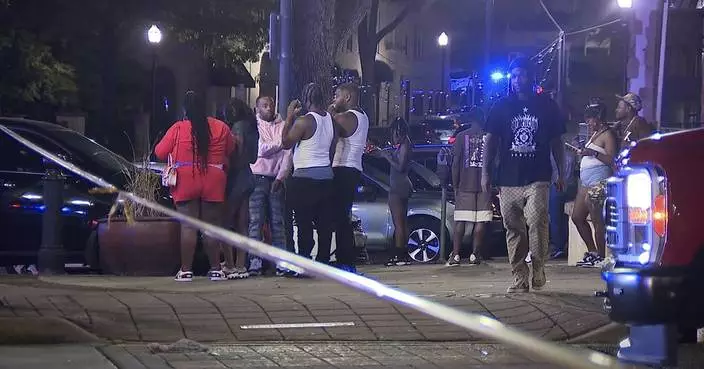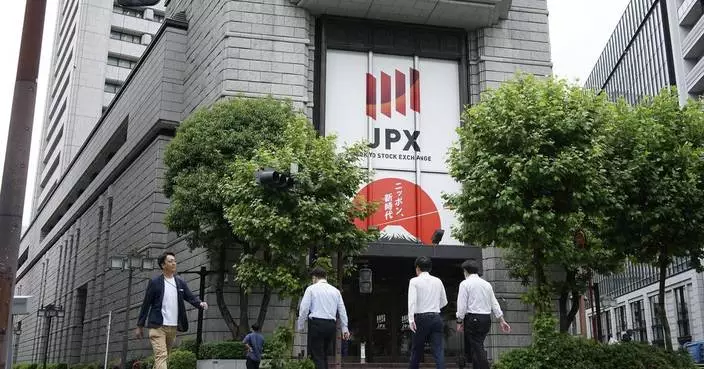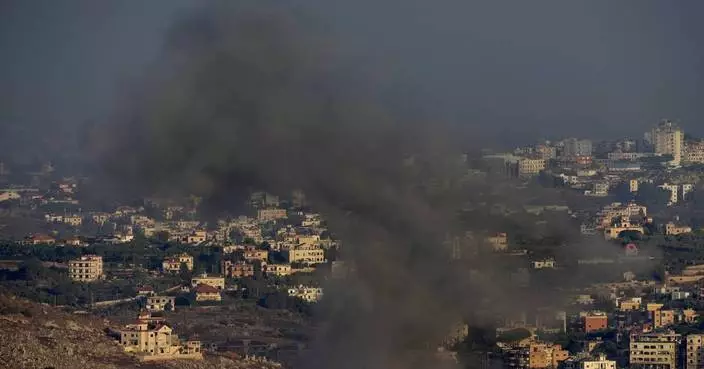NEW YORK (AP) — The New York City police department is lax in punishing officers who illegally stop and frisk people on the street, undermining efforts to curb wrongful uses of the tactic than a judge declared unconstitutional more than a decade ago, a court-ordered study has found.
James Yates, a retired New York state judge, wrote in a report made public Monday that most of the dozens of internal disciplinary cases for stop-and-frisk violations that he reviewed resulted in reduced penalties or no discipline.
“Discipline for illegal stops and frisks” is not pursued “with the same vigor and resolve as for other misconduct,” Yates wrote in the 503-page report. “Penalties for wrongdoing involving stops, questions, frisks, or searches of persons, even when repeated, are rare.”
The NYPD's discipline matrix lists a three-day penalty for an illegal stop, frisk or search, but “imposition of that level of discipline is a rarity" and the department's patrol guide permits guidance rather than penalties in “isolated cases of erroneous but good-faith stops or frisks," Yates wrote.
Officers are disciplined either based on the recommendation of a panel at the city’s police watchdog agency, the Civilian Complaint Review Board, or after an internal NYPD investigation. Those findings are sent to the police commissioner, who has the final say on internal discipline and punishment, though some minor or technical infractions are handled at the precinct level.
Over time, NYPD commissioners “have demonstrated an inordinate willingness to excuse illegal stops, frisks, and searches in the name of ‘good faith’ or ‘lack of mal-intention,’” Yates wrote. That prerogative is “relegating Constitutional adherence to a lesser rung of discipline,” he said.
The NYPD said it will review the report and provide feedback as directed. The CCRB said it is also reviewing the report.
U.S. District Judge Analisa Torres, who has been overseeing NYPD reforms in the wake of the 2013 stop-and-frisk ruling, requested the report — an “in-depth, critical examination of the efficacy, fairness, and integrity” of the NYPD's “policies, practices and procedures” regarding stop-related misconduct.
Torres invited the public, the city and parties to stop-and-frisk-related litigation to submit comments on the findings by Dec. 25, suggesting she may wait until after that point to take further action.
Center for Constitutional Rights lawyer Samah Sisay said the report's findings “show that even 10 years after the landmark ruling in our cases, the NYPD is failing to address unconstitutional conduct by officers.” Sisay, whose organization filed the lawsuit leading to the 2013 ruling, said: "It is perfectly clear that there is a need for real transparency and accountability because the police should not be trusted to police themselves.”
Yates' findings were posted on Torres' court docket Monday amid upheaval in the NYPD's leadership.
Edward Caban resigned as police commissioner on Sept. 12 after federal authorities seized his electronic devices as part of an investigation that also involved his brother, a former police officer. On Saturday, interim Commissioner Thomas Donlon disclosed that a day earlier, federal authorities searched his homes. He said they took materials that came into his possession about 20 years ago and are unrelated to his NYPD work.
Yates, who served as a judge in Manhattan criminal and civil courts from 1992 to 2011, conducted the examination on behalf of Mylan Denerstein, the federal monitor whose team helped develop policy, training, supervision and discipline reforms and regularly submits reports to Torres on the NYPD's progress in implementing them.
In 2013, U.S. District Judge Shira Scheindlin ruled that the NYPD had violated the civil rights of Black and Hispanic New Yorkers with its widespread use of stop and frisk. The tactic was part of an effort to get guns and drugs off the street by frequently stopping and searching people.
Scheindlin, now retired, ruled that the stops were a form of indirect racial profiling. Former Mayor Michael Bloomberg, once a champion of the tactic, has since apologized for its use.
Since the ruling, the department has claimed a sharp drop in stops since a high of nearly 686,000 in 2011. The NYPD reported an average of around 12,000 stops per year from 2016 to 2019, dropping to 9,544 in 2020 and 8,948 in 2021. The number of reported stops jumped to 15,102 in 2022, and 16,971 in 2023, according to Yates' report.
Black people continue to be the targets of most stops, the report found, accounting for 59% in 2022 — up from an average of 52% from 2004 to 2012.
Yates recommended that the NYPD take steps to make its disciplinary process more transparent, including by publicizing its procedures and consulting with the court-appointed monitor on any proposed changes to the penalty matrix for stop-and-frisk related misconduct.
Yates also recommended that the NYPD update its online officer directory to show any substantiated stop-and-frisk allegations accepted by the police commissioner, with the date of incident and specific outcome, including guidance or penalty.
If an accused officer asserts that a stop was made in “good faith," or was a “mistake” or that alleged misconduct was an “isolated” incident, the CCRB panel weighing a disciplinary recommendation should be able to evaluate those claims by having access to all prior investigations related to an alleged stop-and-frisk violation, Yates wrote.
“‘Good faith’ or ‘mistakes’ are to be measured objectively,” the retired judge advised, writing that they "must be an objectively reasonable belief or an objectively reasonable mistake measured by the standard of a reasonably trained police officer’s point of view.”
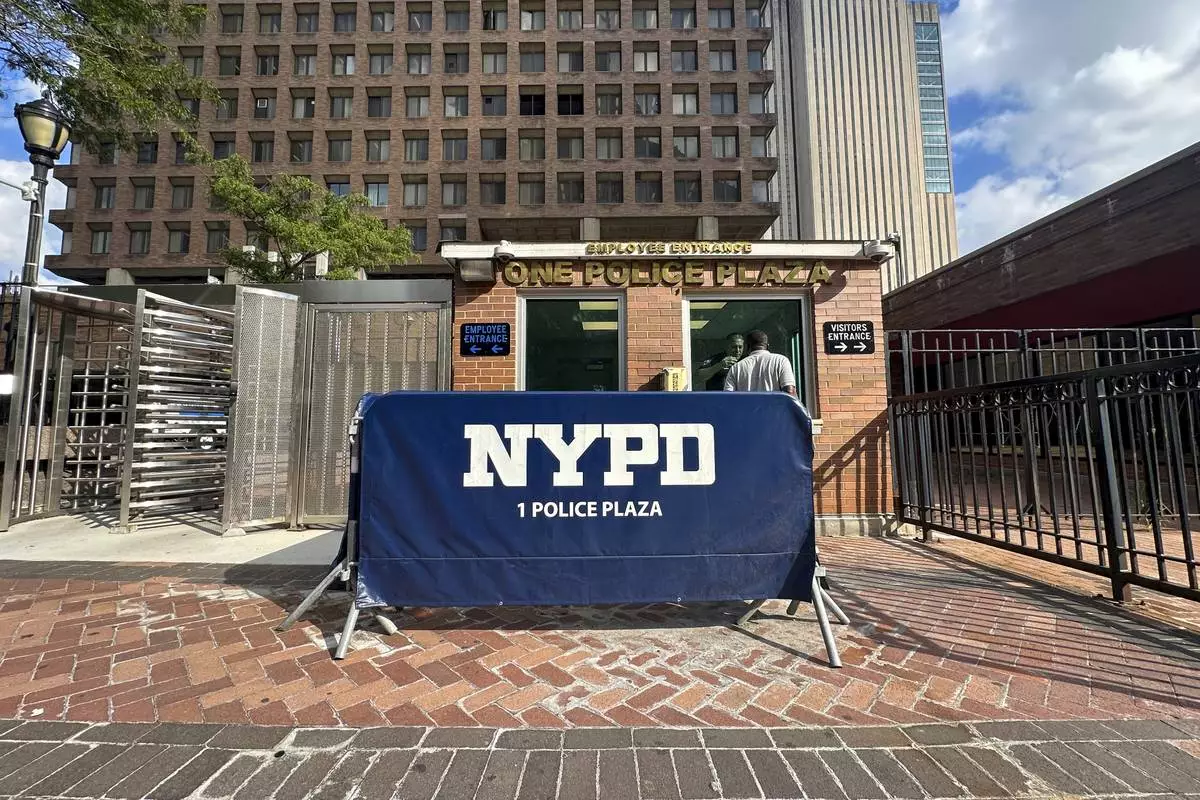
FILE - One Police Plaza, the headquarters of the New York City Police Department, is in lower Manhattan in New York on Sept. 6, 2024. (AP Photo/Ted Shaffrey, file)
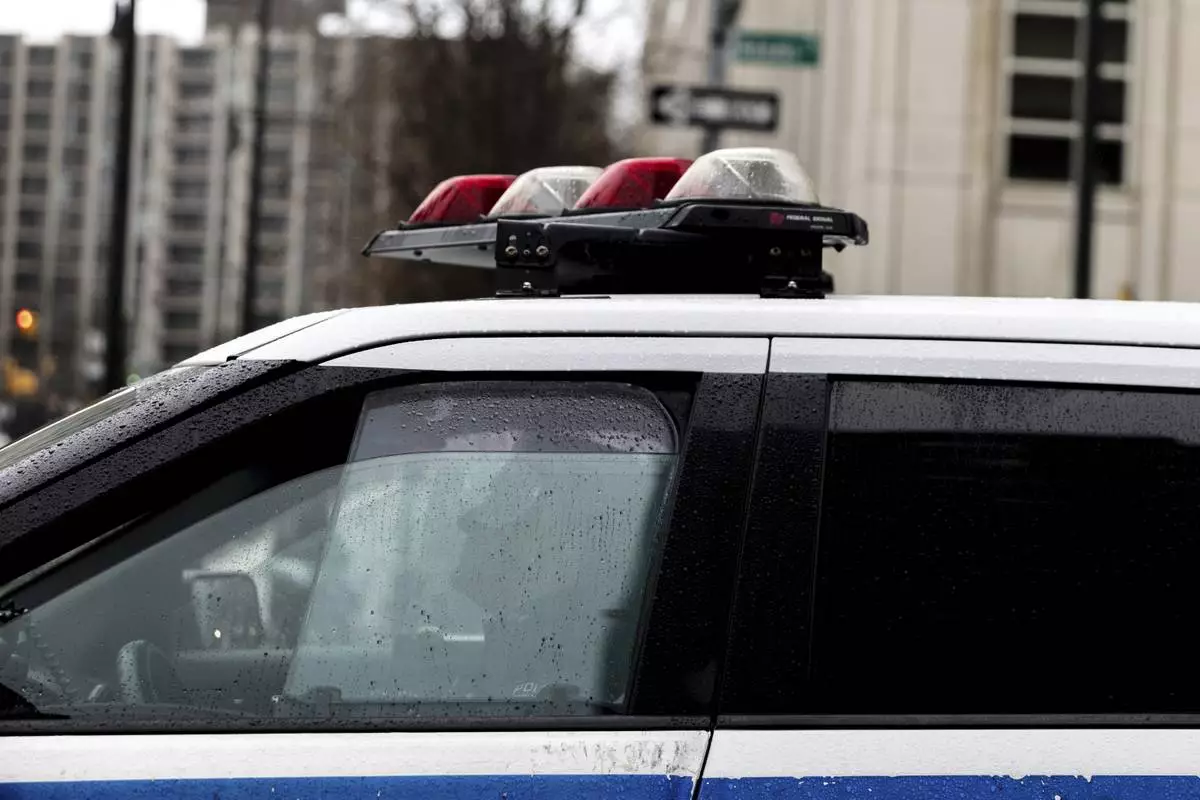
FILE - A police officer sits in a car near the Brooklyn Bridge, Dec. 16, 2022, in the Brooklyn borough of New York. (AP Photo/Julia Nikhinson, file)
CAIRO (AP) — The past week has seen a rapid escalation in the nearly yearlong conflict between Israel and Lebanon’s Hezbollah. First came two days of exploding pagers and walkie-talkies used by Hezbollah — deadly attacks pinned on Israel that also maimed civilians across Lebanon.
Hezbollah’s leader vowed to retaliate, and on Friday the militant group launched a wave of rockets into northern Israel. Later in the day, the commander of Hezbollah’s most elite unit was killed in a strike in Beirut that killed dozens more people.
The cross-border attacks ramped up early Sunday, with Hezbollah, an Iranian-backed Shiite group that is Lebanon’s most powerful armed force, launching more than 100 rockets deeper into northern Israel, with some landing near the city of Haifa. Israel launched hundreds of strikes on Lebanon.
Then, on Monday, Israel launched a series of strikes that killed more than 490 Lebanese, the deadliest attack since the 2006 Israel-Hezbollah war. Israel warned residents in southern and eastern Lebanon to leave their homes ahead of a spreading air campaign against Hezbollah.
Many fear the escalating violence could lead to an all-out war between Israel and Hezbollah, which would further destabilize a region already shaken by the fighting in Gaza. Both sides have said they don't want that to happen, even as they have defiantly warned of heavier attacks.
Israel and Hezbollah have launched repeated strikes against each other since the Gaza war began, but both sides have pulled back when the spiral of reprisals appeared on the verge of getting out of control, under heavy pressure from the U.S. and its allies. But in recent weeks, Israeli leaders have warned of a possible bigger military operation to stop attacks from Lebanon to allow hundreds of thousands of Israelis displaced by the fighting to return to homes near the border.
Here are some things to know about the situation:
More than 1,600 Lebanese were injured in Monday's deadly strikes and thousands more fled southern Lebanon. Israel said it was targeting Hezbollah weapons sites, and had hit some 800 targets. Lebanon's health minister said hospitals, medical centers and ambulances had been struck.
The Israeli military warned residents to immediately leave areas where Hezbollah is storing weapons. The Lebanese media said the evacuation warning was repeated in text messages.
Hezbollah said it had fired dozens of rockets toward Israel, including at military bases, and officials said a series of air-raid sirens were ringing out in northern Israel warning of rocket attacks.
On Friday, an Israeli airstrike brought down a high-rise building in Beirut’s southern suburbs, killing Ibrahim Akil, the commander of Hezbollah’s elite Radwan unit, and other top unit leaders. Israel said Akil led the group’s campaign of rocket, drone and other fire into northern Israel. At least 45 people were killed in that attack and more than 60 wounded.
That strike came after the shock of the electronic device bombings, in which thousands of pagers and walkie-talkies used by Hezbollah detonated on Tuesday and Wednesday. At least 37 people were killed, including two children, and around 3,000 were wounded. Israel has neither confirmed nor denied its involvement.
Analysts say that attack had little effect on Hezbollah’s manpower, but could disrupt its communications and force it to take tighter security measures.
The Israel-Lebanon border has seen almost daily exchanges since the Israel-Hamas war began on Oct. 7. Before Monday, the exchanges had killed around 600 people in Lebanon – mostly fighters but also about 100 civilians — and about 50 soldiers and civilians in Israel. It has also forced hundreds of thousands of people to evacuate homes near the border in both Israel and Lebanon.
Hezbollah leader Hassan Nasrallah promised to retaliate for the electronic device bombings. But Hezbollah also has proved wary of further stoking the crisis. The group faces a difficult balance of stretching the rules of engagement by hitting deeper into Israel in response to its brazen attacks, while at the same time trying to avoid the kind of large-scale attacks on civilian areas that can trigger a full-scale war that it could be blamed for.
Hezbollah says its attacks against Israel are in support of Hamas. Last week, Nasrallah said the barrages won’t end — and Israelis won’t be able to return to homes in the north — until Israel’s campaign in Gaza ends.
Israeli officials say they haven’t yet made an official decision to expand military operations against Hezbollah – and haven’t said publicly what those operations might be. Last week, though, the head of Israel’s Northern Command was quoted in local media as advocating for a ground invasion of Lebanon.
Meanwhile, as fighting in Gaza has slowed, Israel has increased its forces along the Lebanese border, including the arrival of a powerful army division believed to include thousands of troops.
Israeli Defense Minister Yoav Gallant last week declared the start of a “new phase” of the war as Israel turns its focus toward Hezbollah.
“The center of gravity is shifting to the north,” he said.
A U.N.-brokered truce to the 2006 war called on Hezbollah to pull back 29 kilometers (18 miles) from the border, but it has refused, accusing Israel of also failing to carry out some provisions. Israel is now demanding Hezbollah withdraw eight to 10 kilometers (five to six miles) from the border – the range of Hezbollah’s anti-tank guided missiles.
The monthlong 2006 war, triggered when Hezbollah fighters kidnapped two Israeli soldiers, included heavy Israeli bombardment of southern Lebanon and Beirut and a ground invasion into the south. The strategy, Israeli commanders later said, was to inflict maximum damage in areas where Hezbollah operated to deter them from launching attacks.
But Israel could have a more ambitious goal this time: to seize a buffer zone in south Lebanon to push back Hezbollah fighters from the border. A fight to hold territory threatens a longer, even more destructive and destabilizing war – recalling Israel’s 1982-2000 occupation of southern Lebanon.
The fear is that a new war could be even worse than the one in 2006, which was traumatic enough for both sides to serve as a deterrent ever since.
The fighting then killed hundreds of Hezbollah fighters and an estimated 1,100 Lebanese civilians and left large swaths of the south and even parts of Beirut in ruins. More than 120 Israeli soldiers were killed and hundreds wounded. Hezbollah missile fire on Israeli cities killed dozens of civilians.
Israel estimates that Hezbollah now possesses about 150,000 rockets and missiles, some of which are precision-guided, putting the entire country within range. Israel has beefed up air defenses, but it’s unclear whether it can defend against the intense barrages of a new war.
Israel has vowed it could turn all of southern Lebanon into a battle zone, saying Hezbollah has embedded rockets, weapons and forces along the border. And in the heightened rhetoric of the past months, Israeli politicians have spoken of inflicting the same damage in Lebanon that the military has wreaked in Gaza.
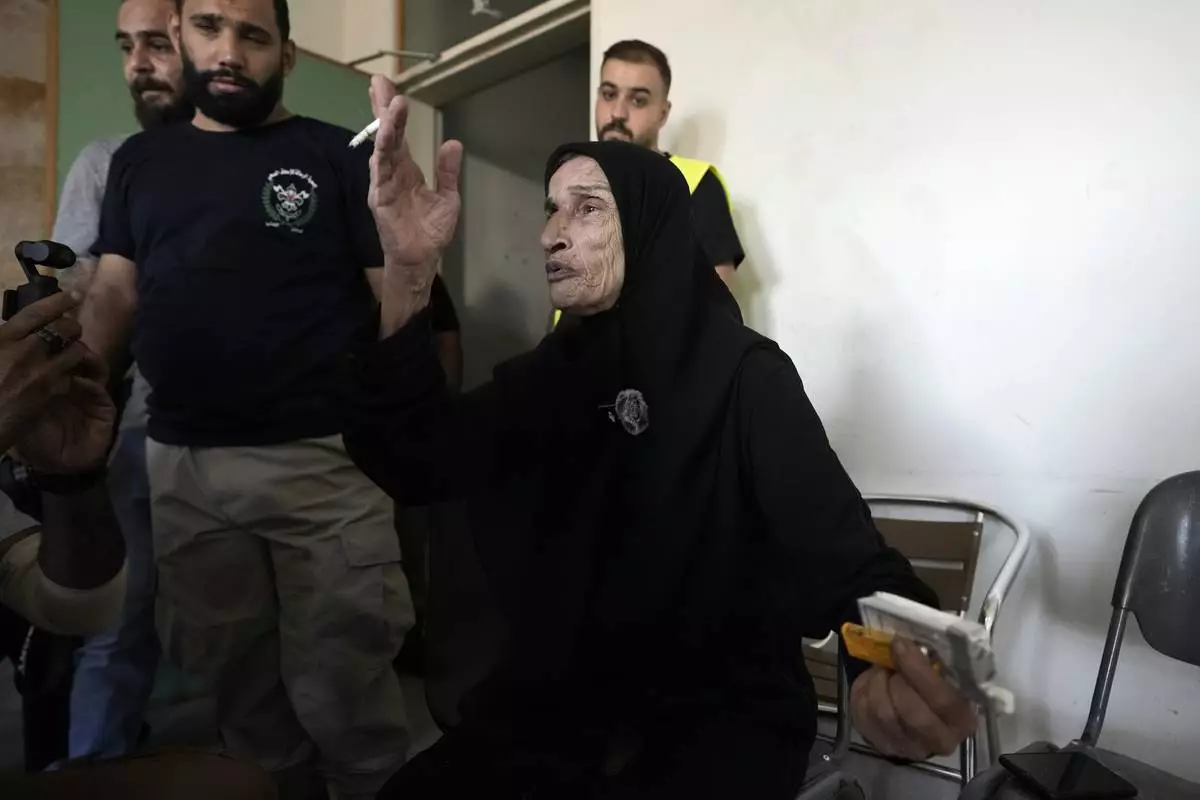
A woman, who fled the Israeli airstrikes in the south, reacts as she arrives at a school turned into a shelter in Beirut, Monday, Sept. 23, 2024. (AP Photo/Bilal Hussein)
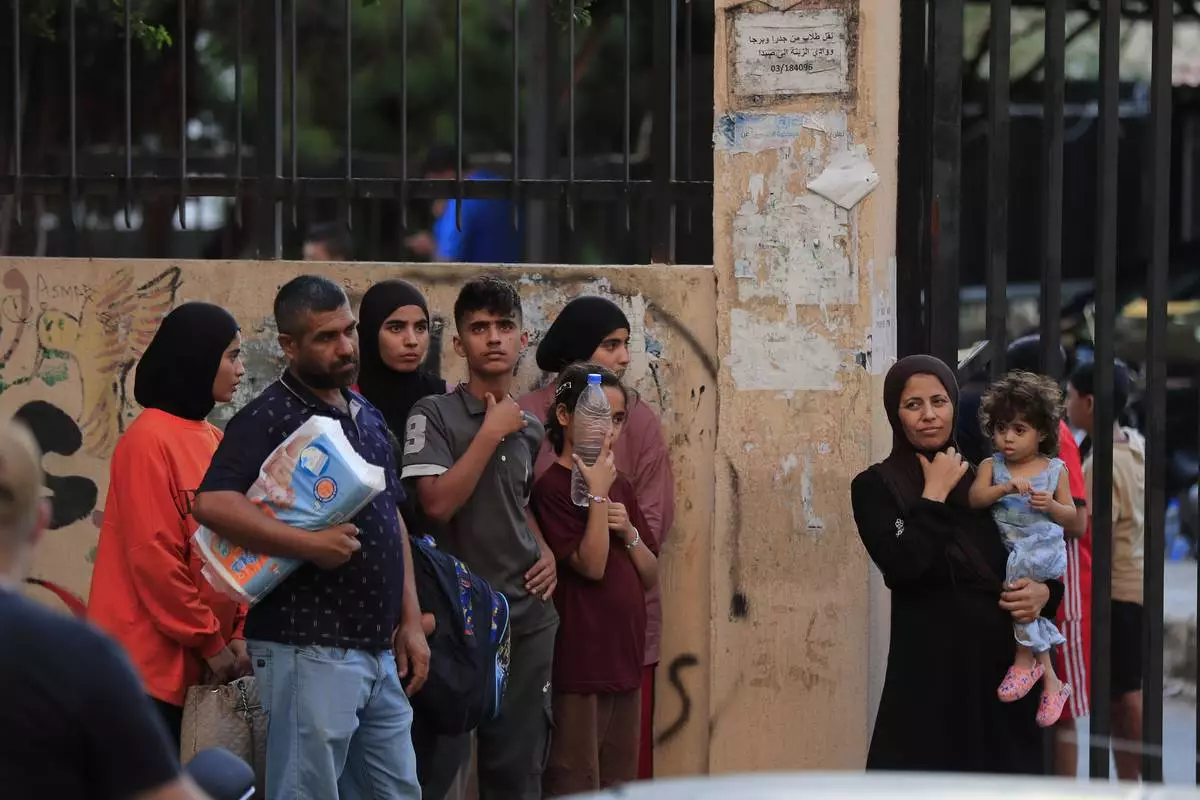
People fleeing the southern villages amid ongoing Israeli airstrikes, stand outside a school turned into a shelter in Sidon, Monday, Sept. 23, 2024. (AP Photo/Mohammed Zaatari)
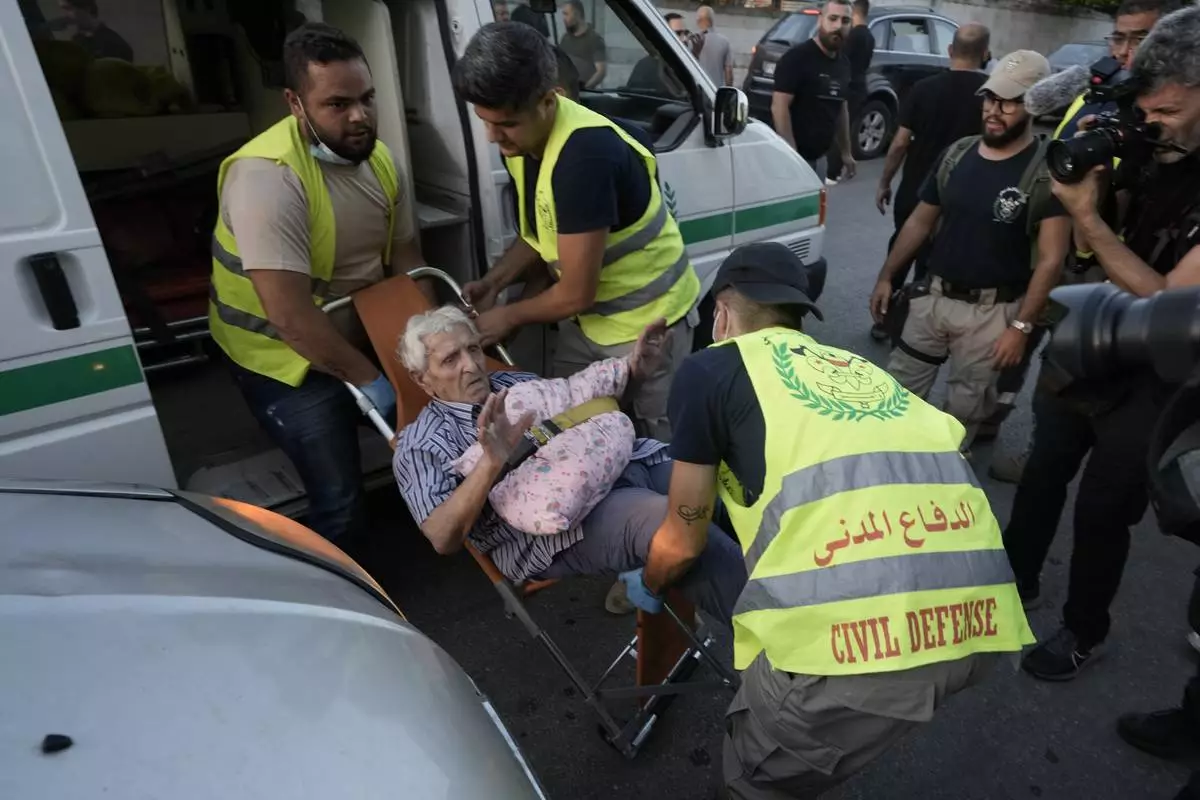
Civil defense workers carry an elderly, fleeing the south, as he arrives at a school turned into a shelter in Beirut, Monday, Sept. 23, 2024. (AP Photo/Bilal Hussein)
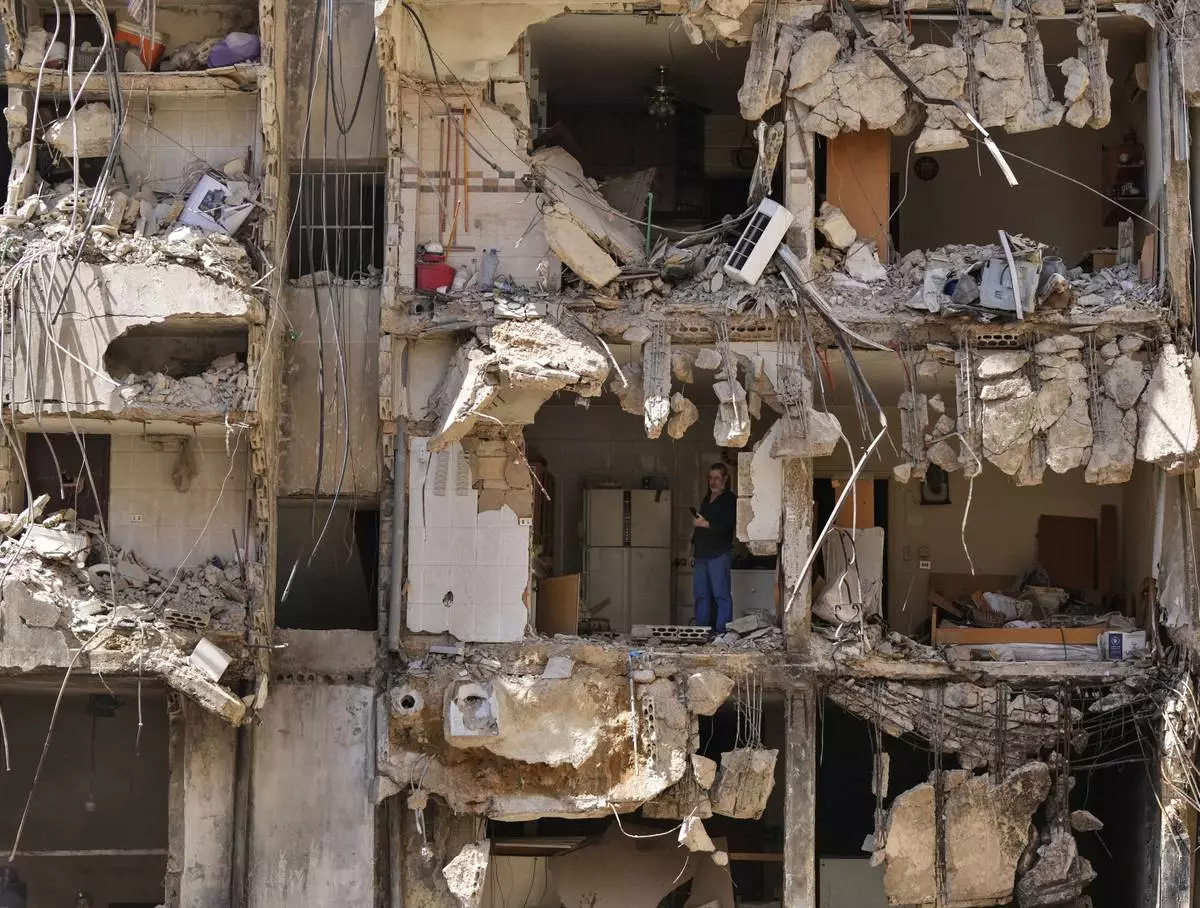
A man watches rescuers sift through the rubble as they search for people still missing at the site of Friday's Israeli strike in Beirut's southern suburbs, Monday, Sept. 23, 2024. (AP Photo/Hassan Ammar)

Israeli Iron Dome air defense system fires to intercept rockets that were launched from Lebanon into northern Israel, as seen from Hadera, Monday, Sept. 23, 2024. (AP Photo/Ariel Schalit)
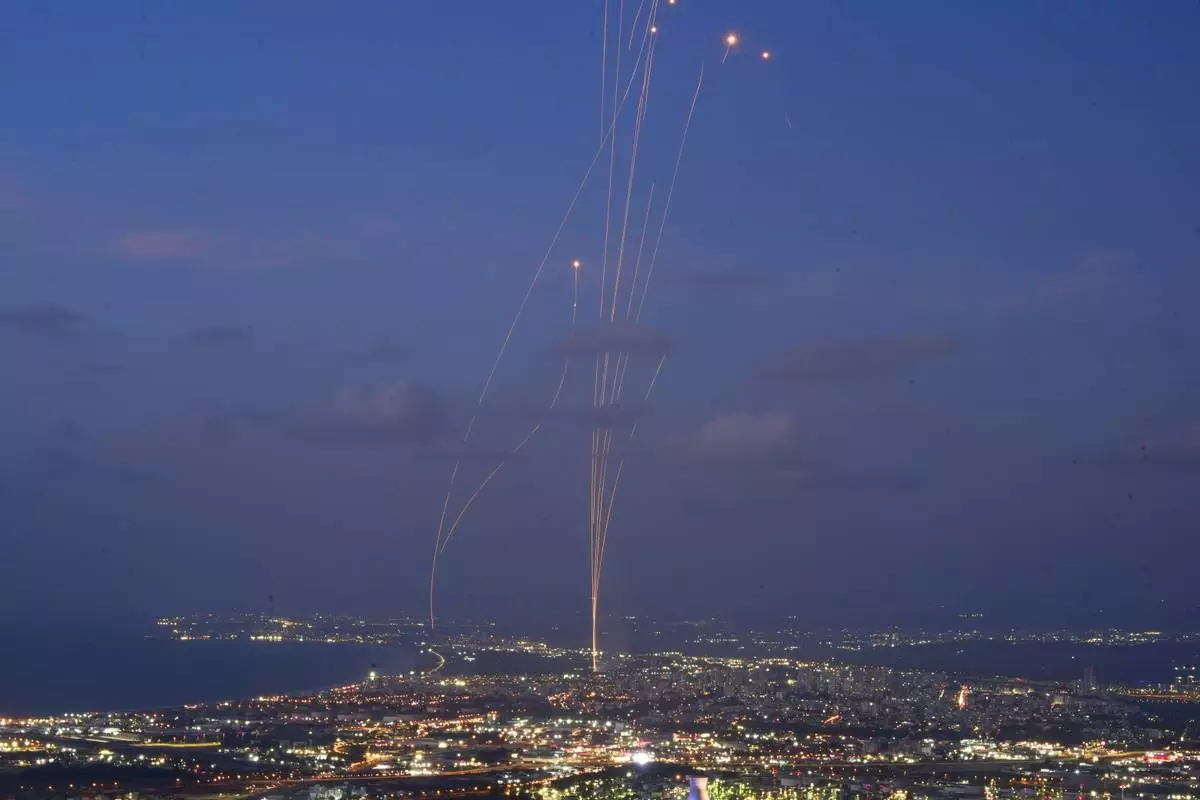
Israeli Iron Dome air defense system fires to intercept rockets that were launched from Lebanon, as seen from Haifa, northern Israel, Monday, Sept. 23, 2024. (AP Photo/Baz Ratner)
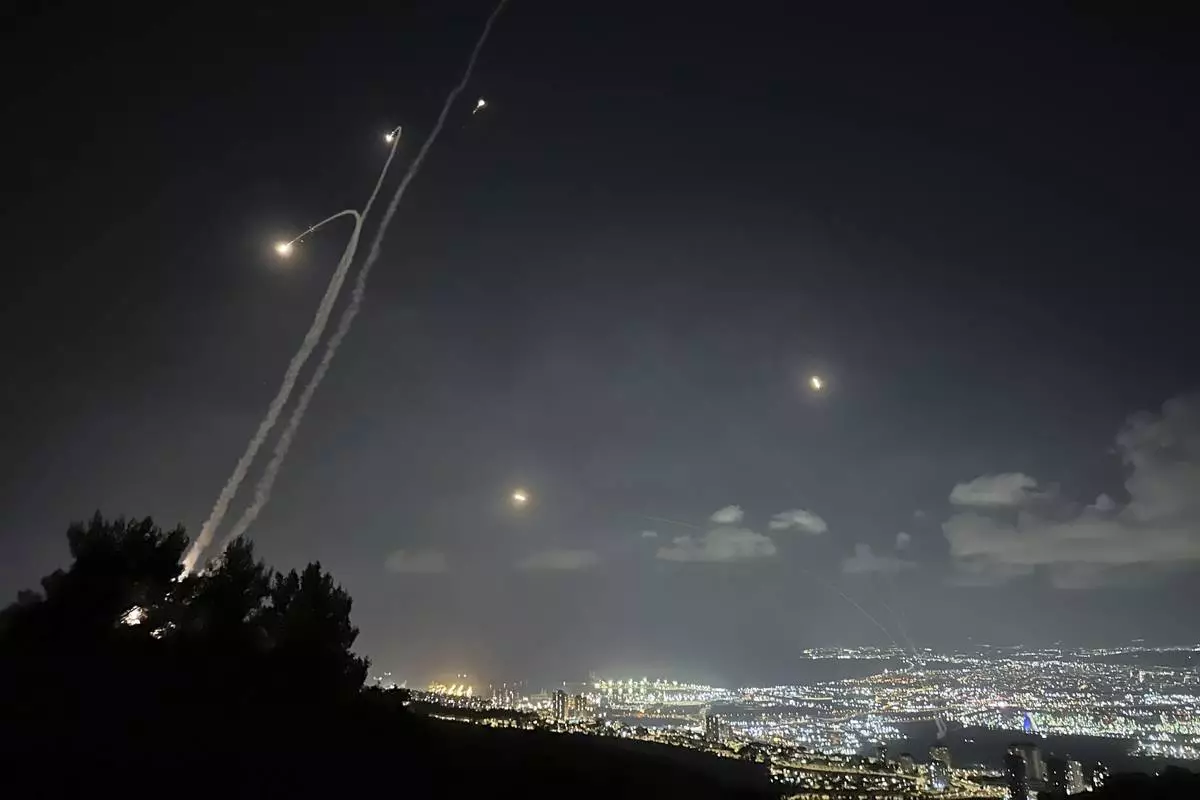
Israeli Iron Dome air defense system fires to intercept rockets that were launched from Lebanon, as seen from Haifa, northern Israel, Monday, Sept. 23, 2024. (AP Photo/Baz Ratner)
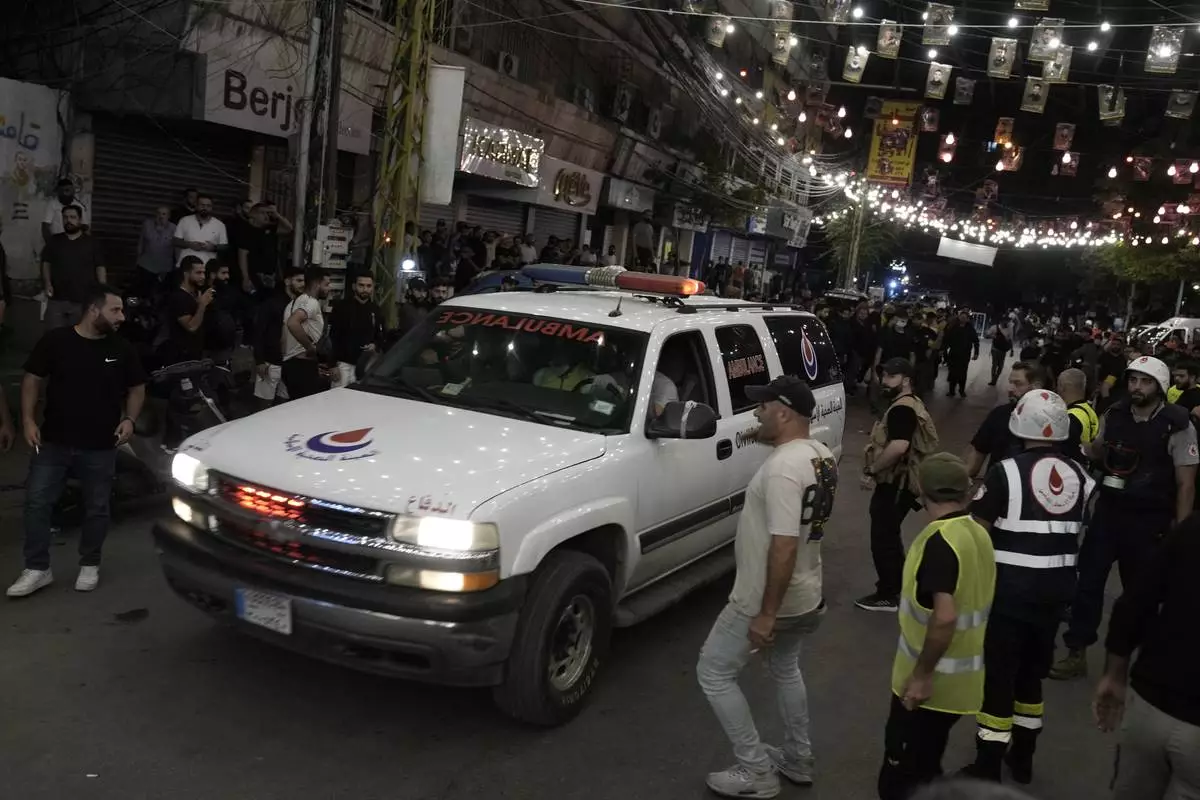
Ambulances arrive to evacuate the wounded near the site of an Israeli airstrike in Beirut's southern suburb, Monday, Sept. 23, 2024. (AP Photo/Bilal Hussein)
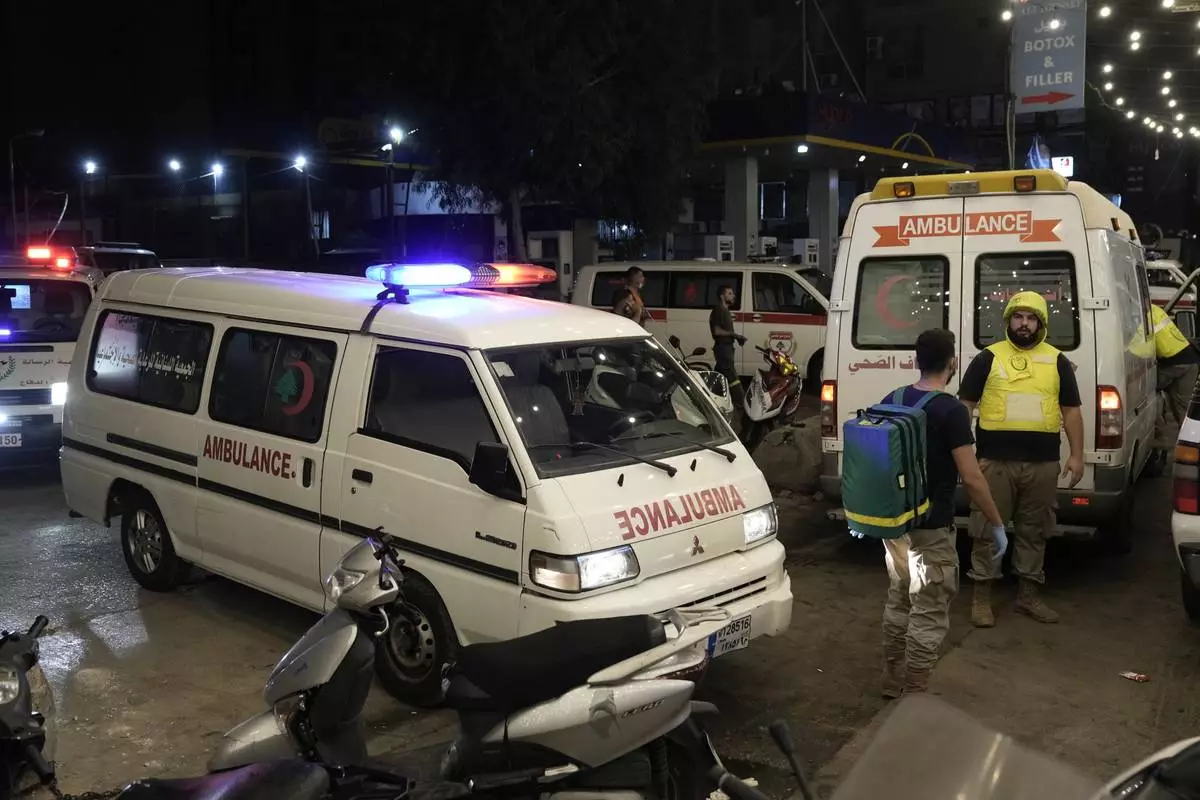
Ambulances arrive to evacuate the wounded near the site of an Israeli airstrike in Beirut's southern suburb, Monday, Sept. 23, 2024. (AP Photo/Bilal Hussein)
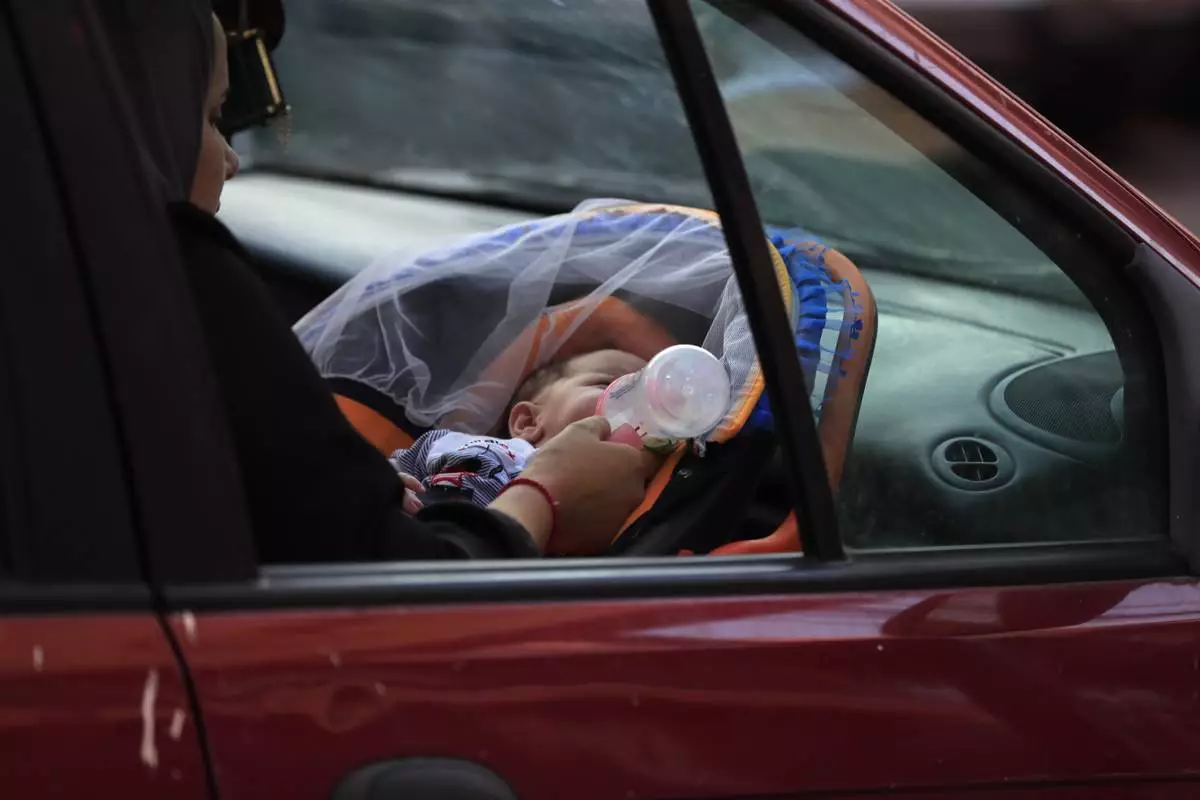
A woman feeds her newborn in a car in Sidon, Lebanon, as she flees the southern villages amid ongoing Israeli airstrikes, Monday, Sept. 23, 2024. (AP Photo/Mohammed Zaatari)

Cars sit in traffic as people flee the southern villages amid ongoing Israeli airstrikes, in Sidon, Lebanon, Monday, Sept. 23, 2024. (AP Photo/Mohammed Zaatari)
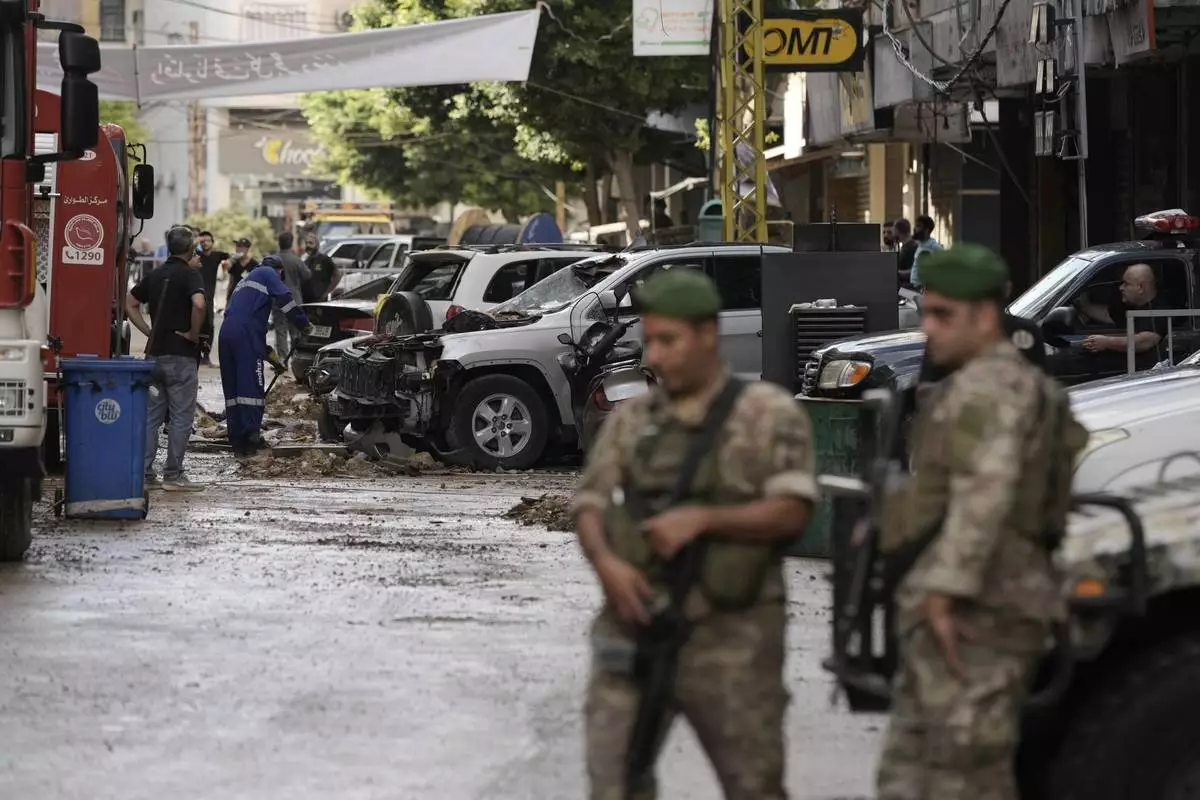
Lebanese soldiers stand guard near the site of Friday's Israeli strike in Beirut's southern suburb, Sunday, Sept. 22, 2024. (AP Photo/Bilal Hussein)
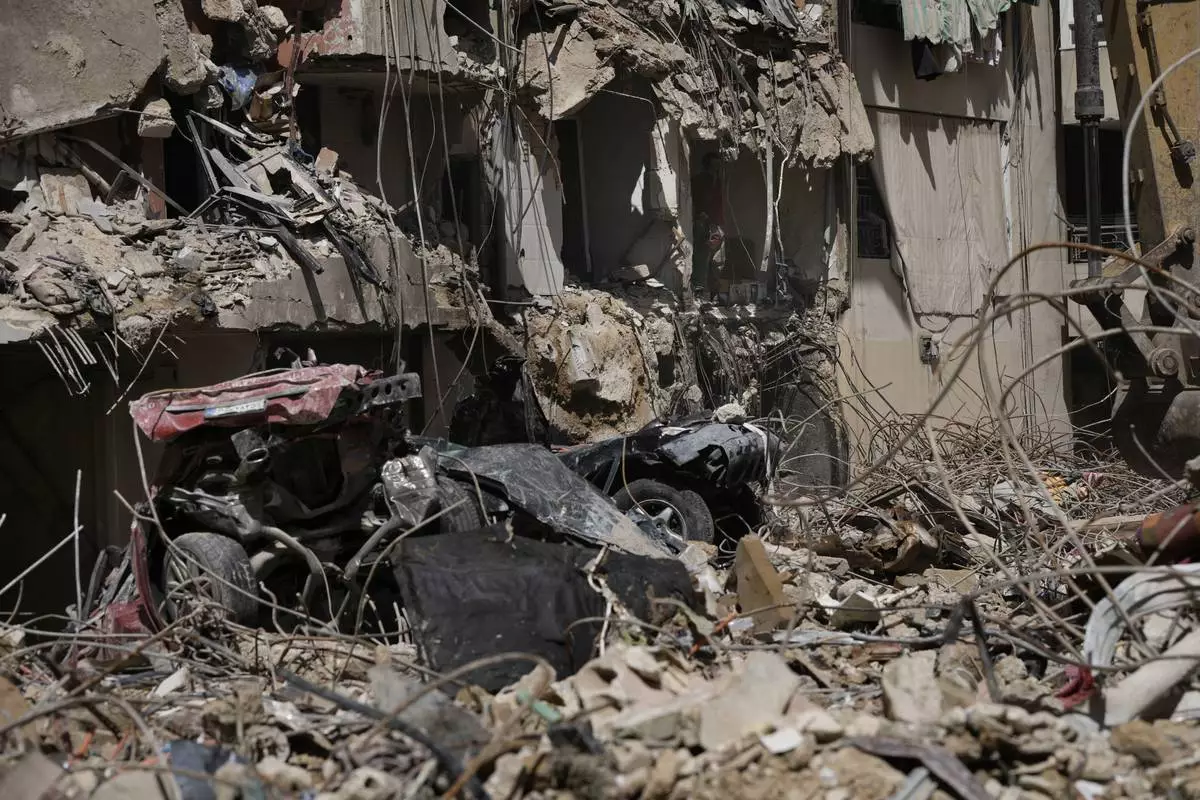
An emergency worker speaks on the phone during rescue efforts at the site of Friday's Israeli strike in Beirut's southern suburb, Sunday, Sept. 22, 2024. (AP Photo/Bilal Hussein)
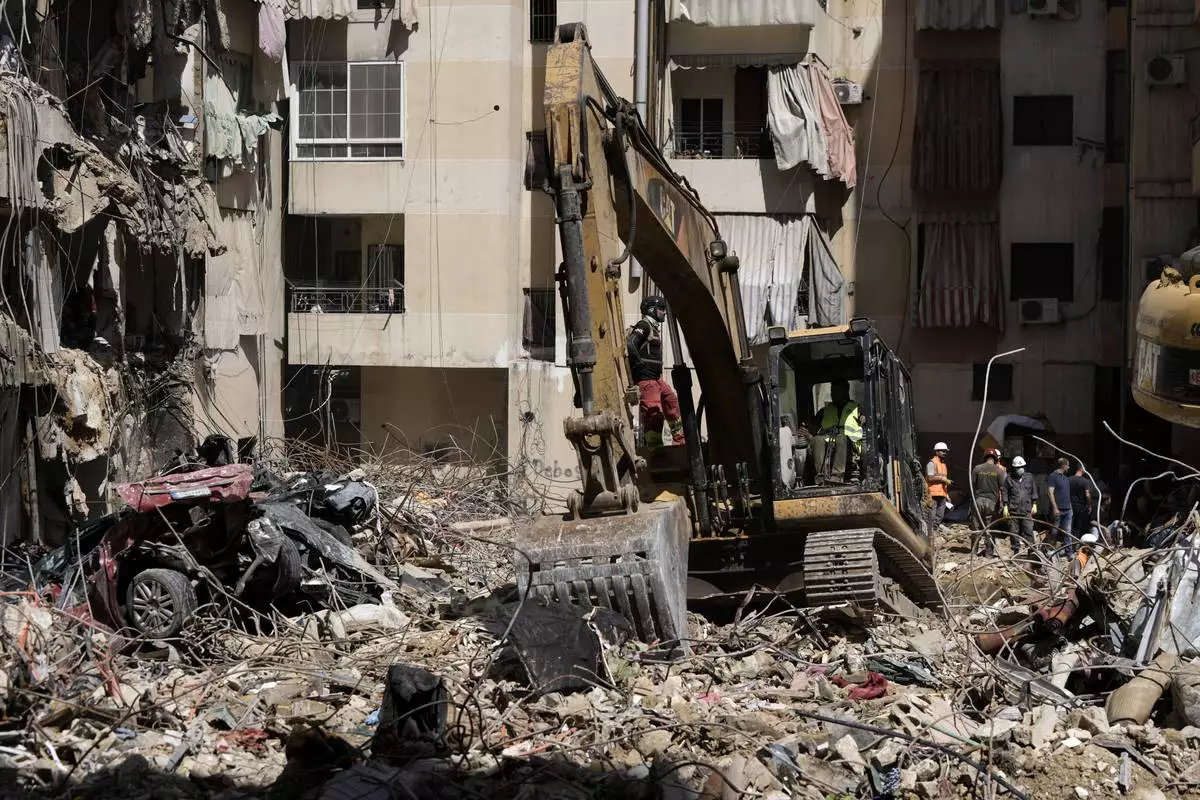
Emergency workers clear the rubble at the site of Friday's Israeli strike in Beirut's southern suburb, Sunday, Sept. 22, 2024. (AP Photo/Bilal Hussein)
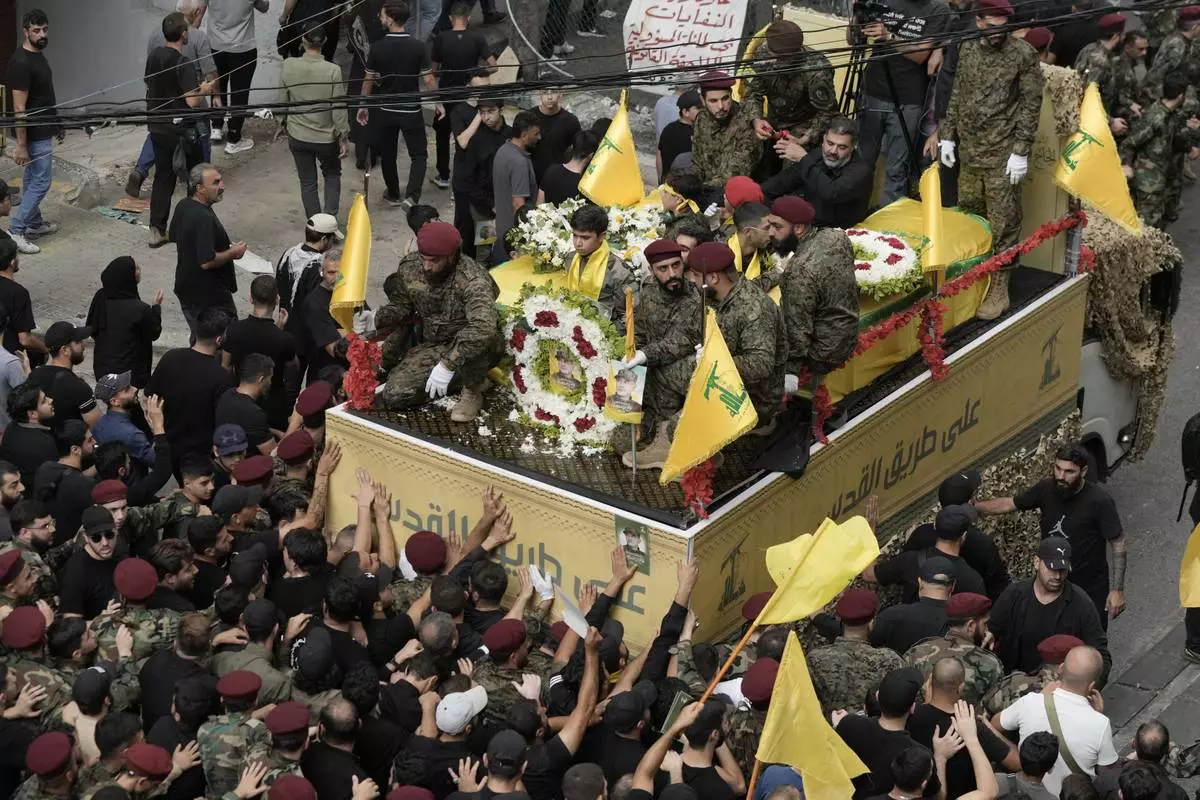
Hezbollah supporters march behind the hearse carrying the coffins of Hezbollah commander Ibrahim Akil and militant Mahmoud Hamad during their funeral procession in Beirut's southern suburb, Sunday, Sept. 22, 2024. (AP Photo/Bilal Hussein)
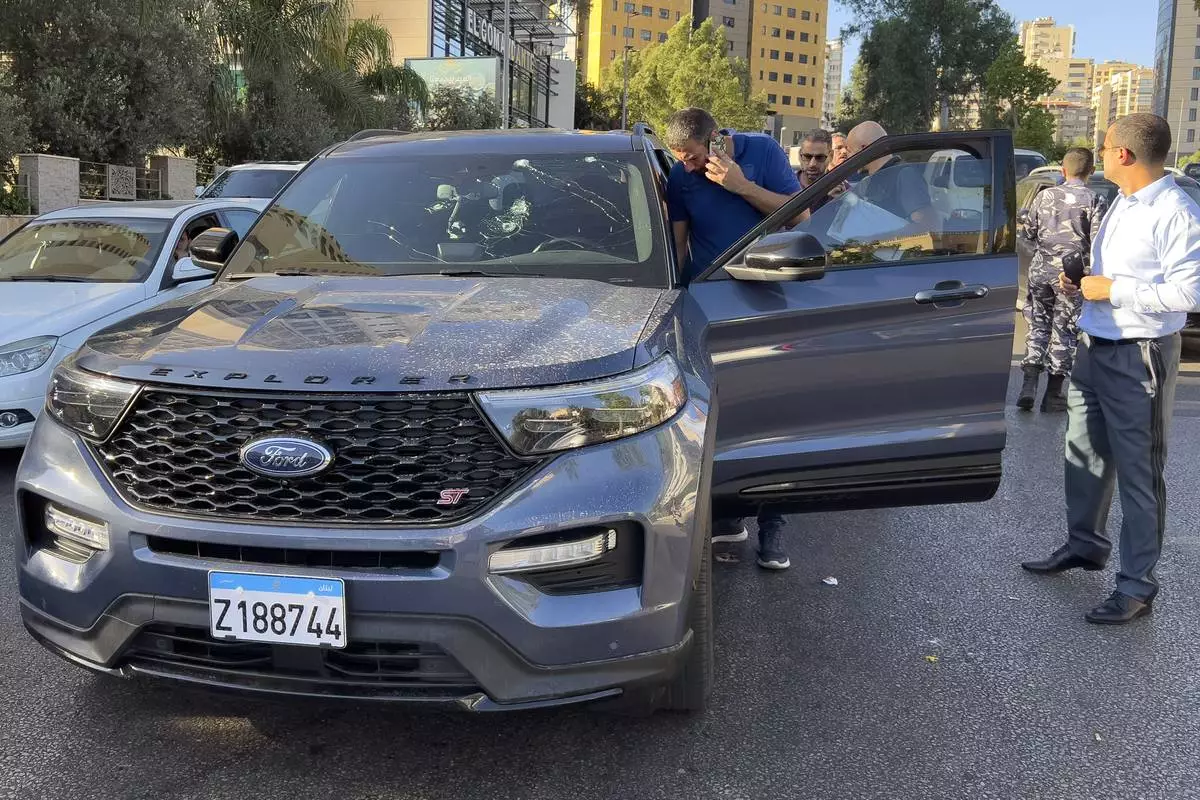
Police officers inspect a car inside of which a hand-held pager exploded, Beirut, Lebanon, Tuesday, Sept. 17, 2024. (AP Photo/Hussein Malla)

Lebanese soldiers and firefighters gather outside a mobile shop after what is believed to be the result of a walkie-talkie exploding inside it, in the southern port city of Sidon, Lebanon, Wednesday, Sept. 18, 2024. (AP Photo/Mohammed Zaatari)
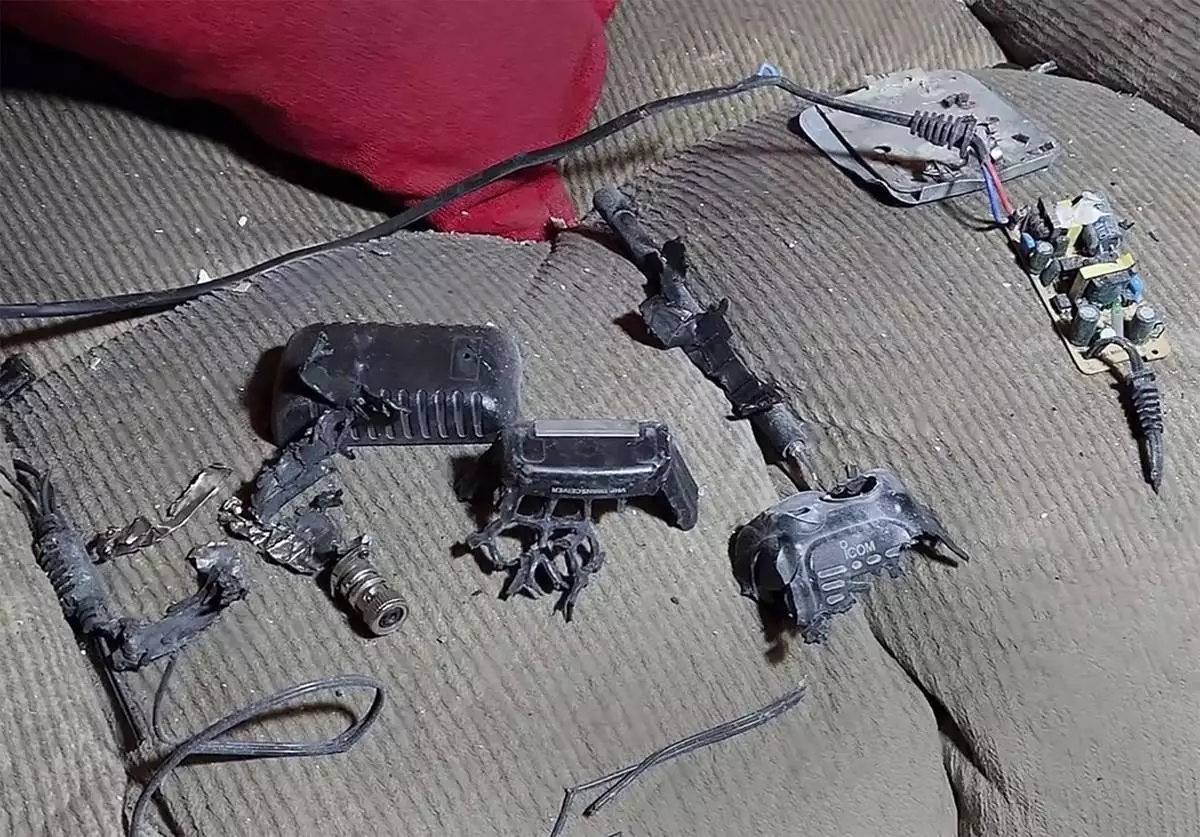
This video grab, shows a walkie-talkie that was exploded inside a house, in Baalbek, east Lebanon, Wednesday, Sept. 18, 2024. (AP Photo)
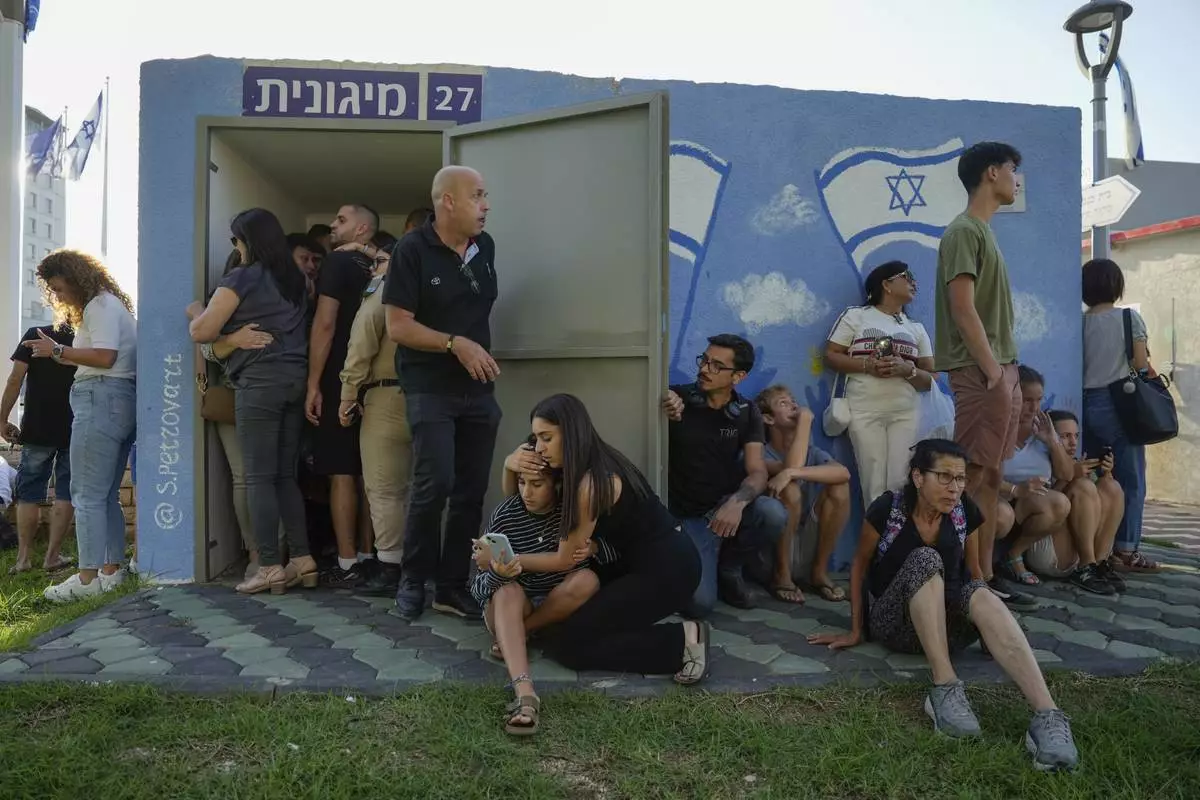
Israelis take cover next to a shelter as a siren sounds a warning of incoming rockets fired from Lebanon, in Nahariya, northern Israel, Thursday, Sept. 19, 2024. (AP Photo/Baz Ratner)
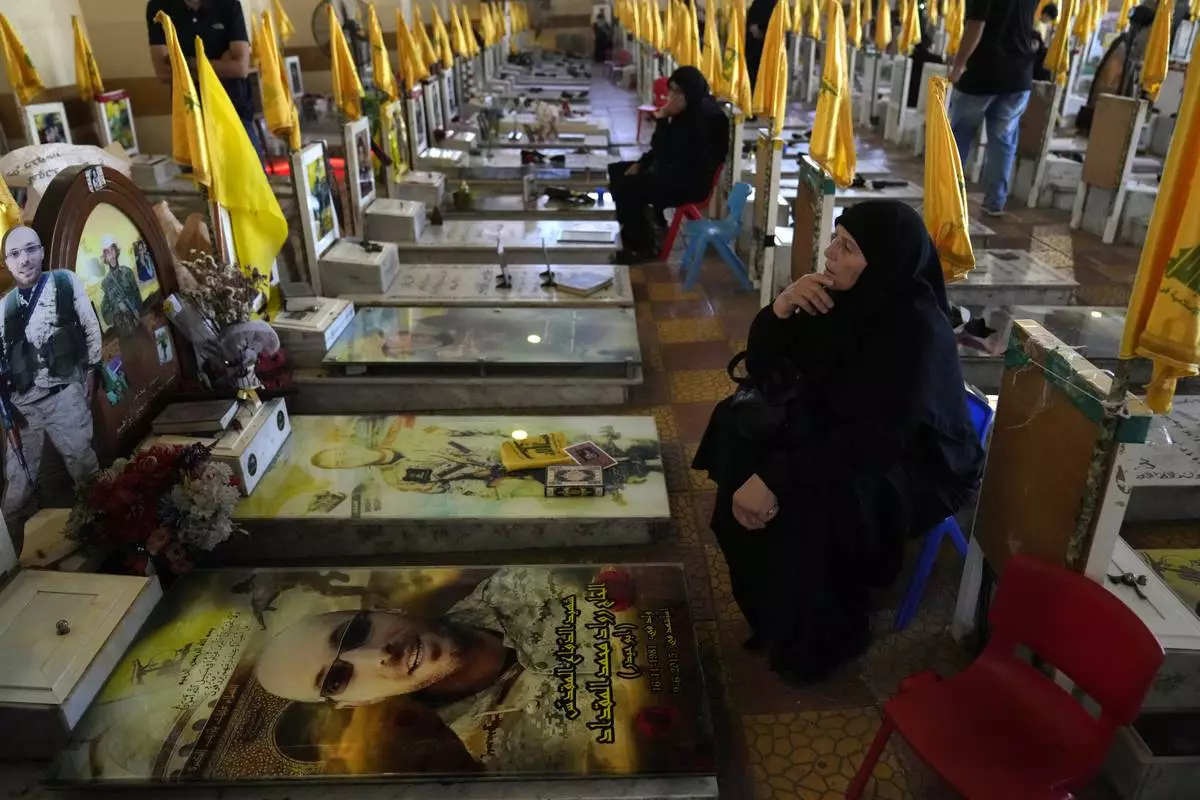
Women sit in a cemetery as they visit the graves of killed Hezbollah members in the southern suburbs of Beirut, Thursday, Sept. 19, 2024. (AP Photo/Hussein Malla)
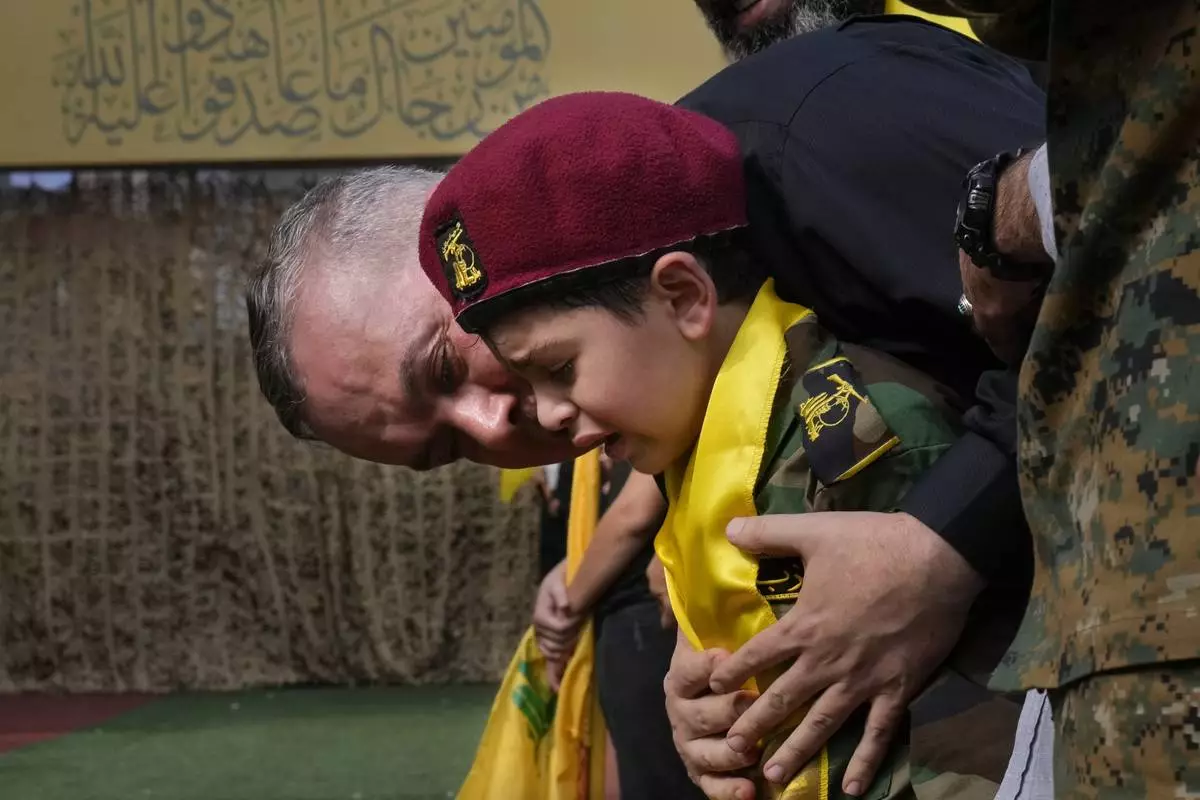
A man comforts a boy crying during the funeral procession of Hezbollah members in the southern suburbs of Beirut, Thursday, Sept. 19, 2024. (AP Photo/Hussein Malla)
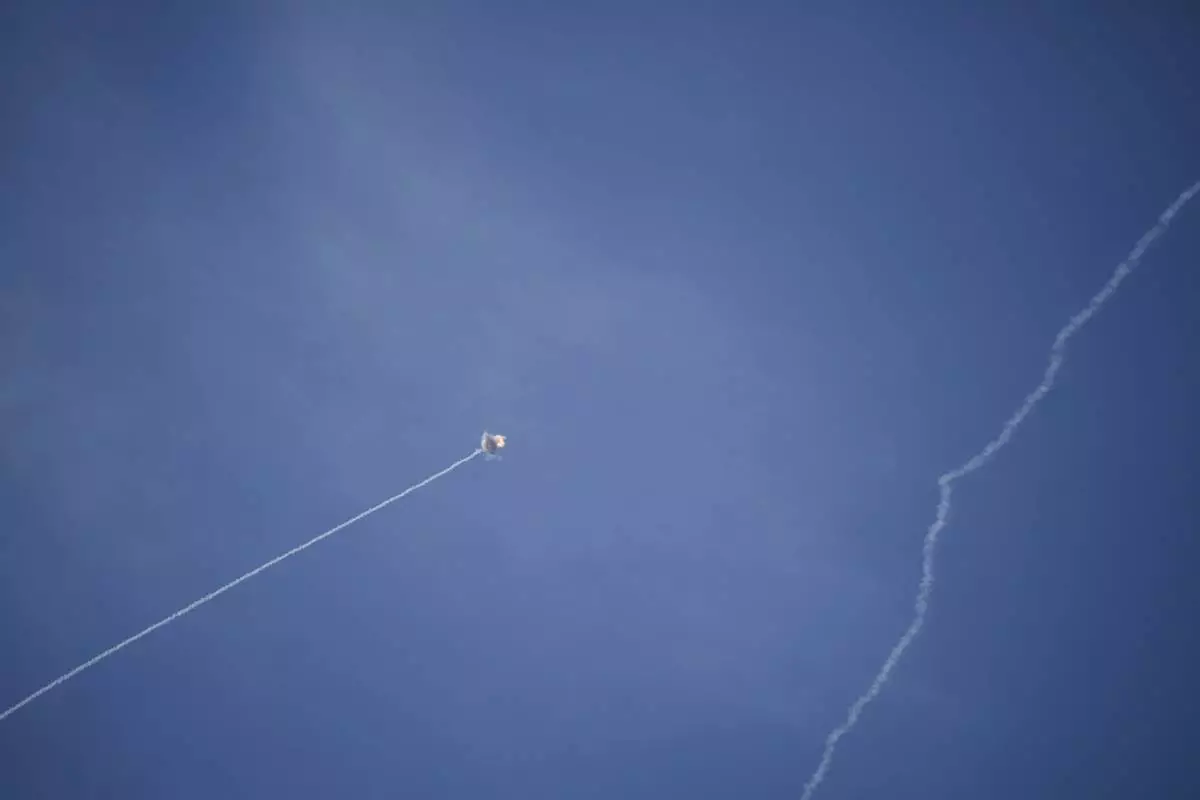
Israeli Iron Dome air defense system fires to intercept a rocket fired from Lebanon, in northern Israel, Friday, Sept. 20, 2024. (AP Photo/Leo Correa)
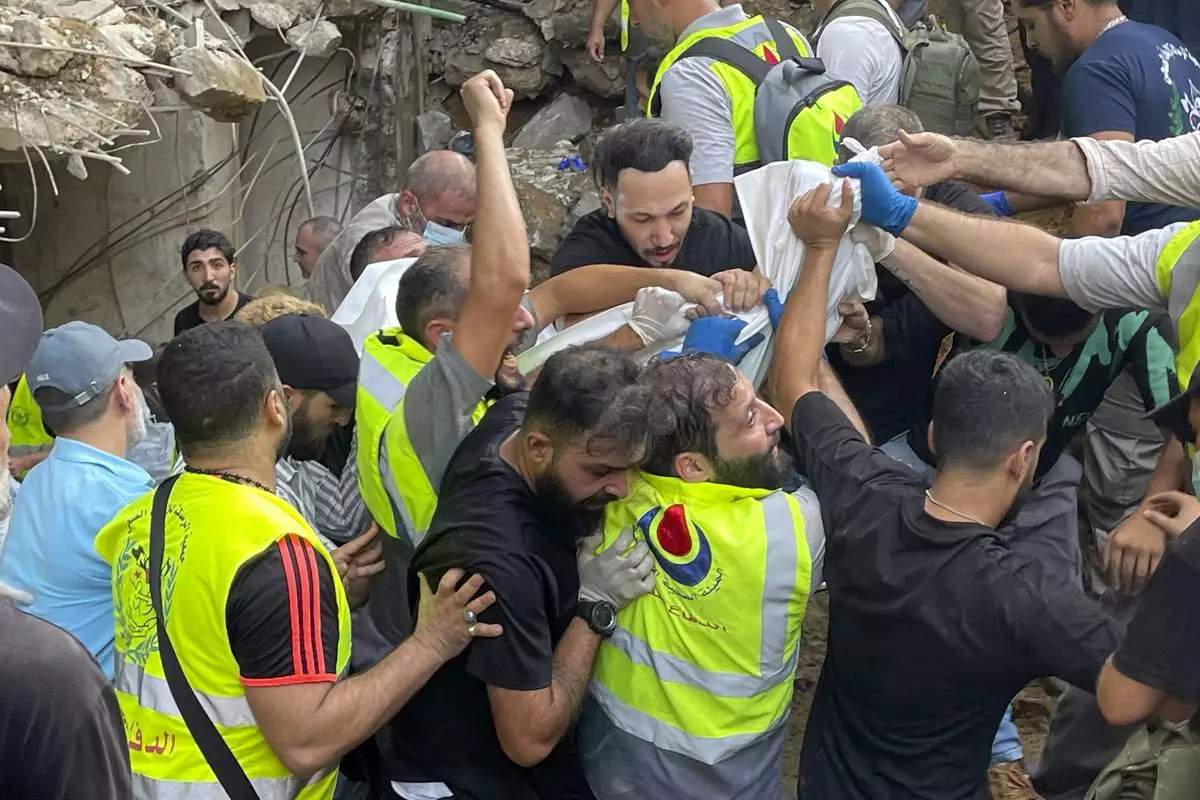
Rescuers carry a body at the scene of a missile strike in the southern suburbs of Beirut, Friday, Sept. 20, 2024. (AP Photo/Bilal Hussein)
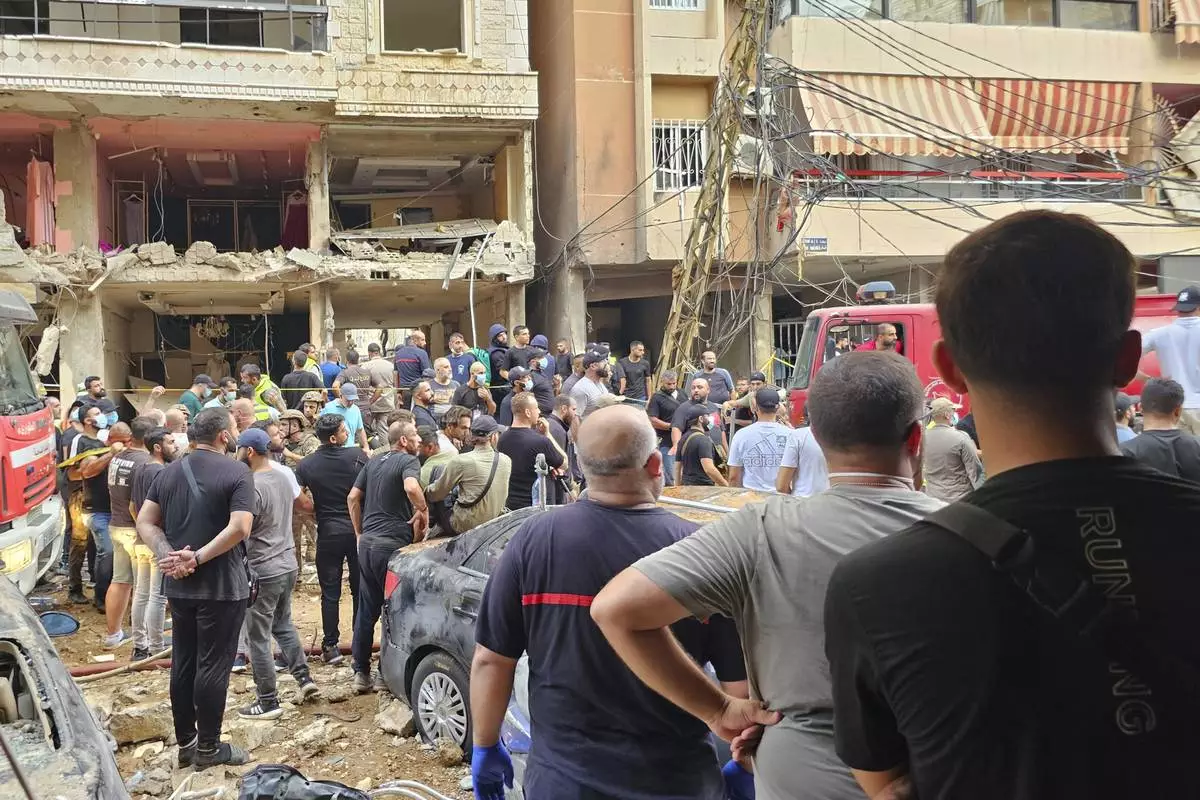
Residents look on as rescuers arrive at the scene of an Israeli missile strike in the southern suburbs of Beirut, Friday, Sept. 20, 2024. (AP Photo/Hassan Ammar)
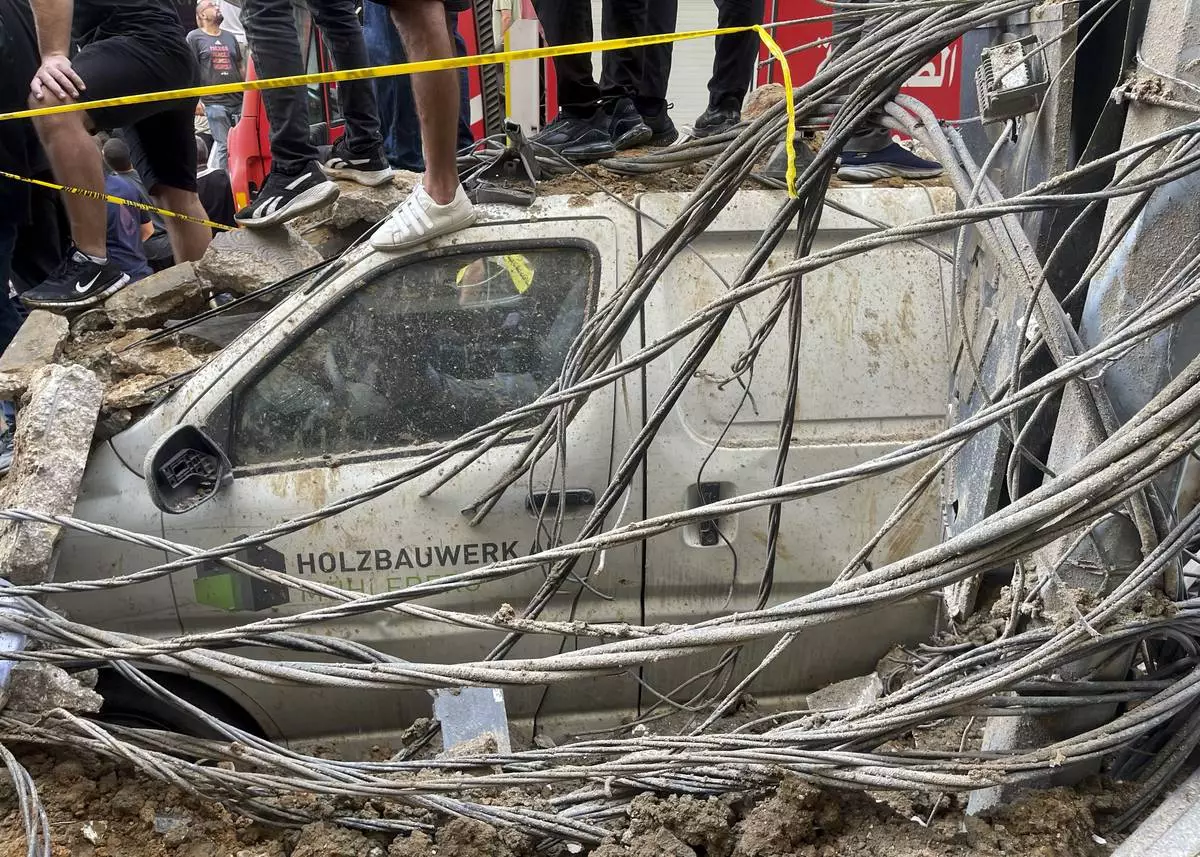
People stand on top of a damaged car at the scene of a missile strike in the southern suburbs of Beirut, Friday, Sept. 20, 2024. (AP Photo/Bilal Hussein)
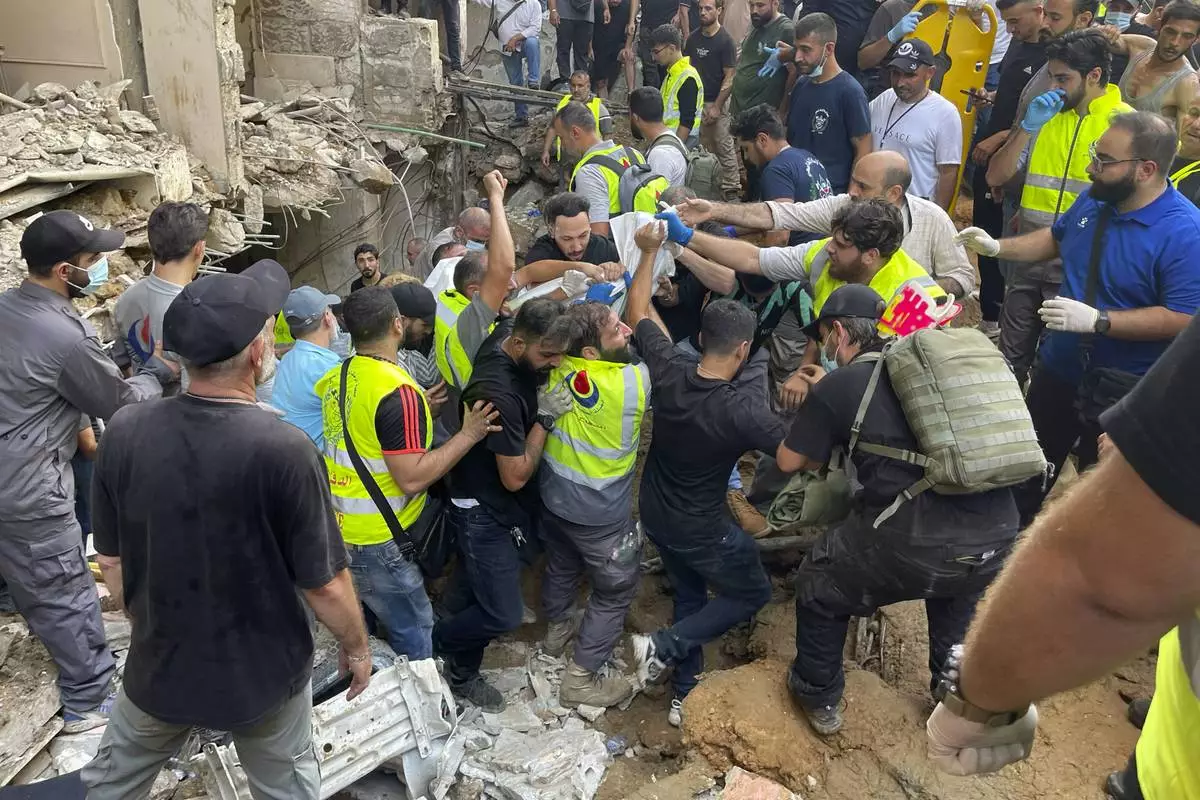
Rescuers carry a body at the scene of a missile strike in the southern suburbs of Beirut, Friday, Sept. 20, 2024. (AP Photo/Bilal Hussein)
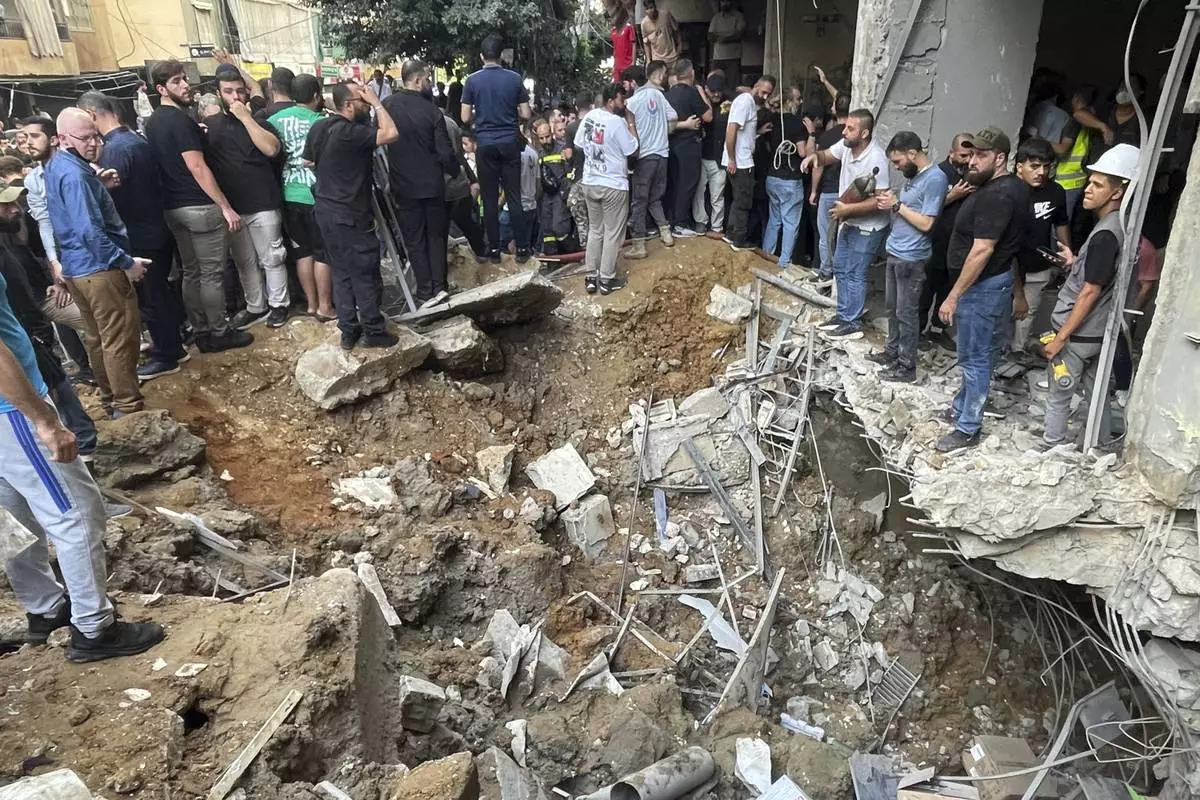
People gather at the scene of an Israeli missile strike in the southern suburbs of Beirut, Friday, Sept. 20, 2024. (AP Photo/Bilal Hussein)
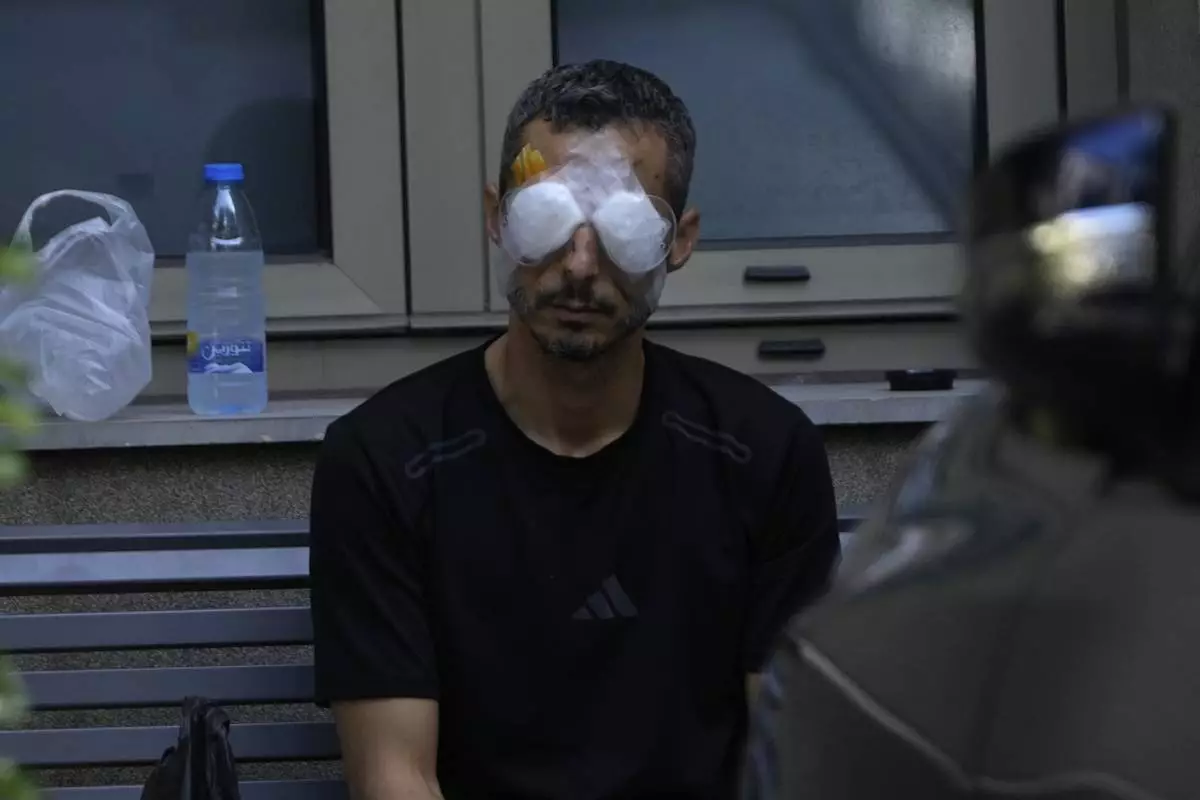
A man who was injured in the explosion of one of the handheld devices, sits outside the Eye Specialist hospital, in Beirut, Lebanon, Friday, Sept. 20, 2024. (AP Photo/Hussein Malla)
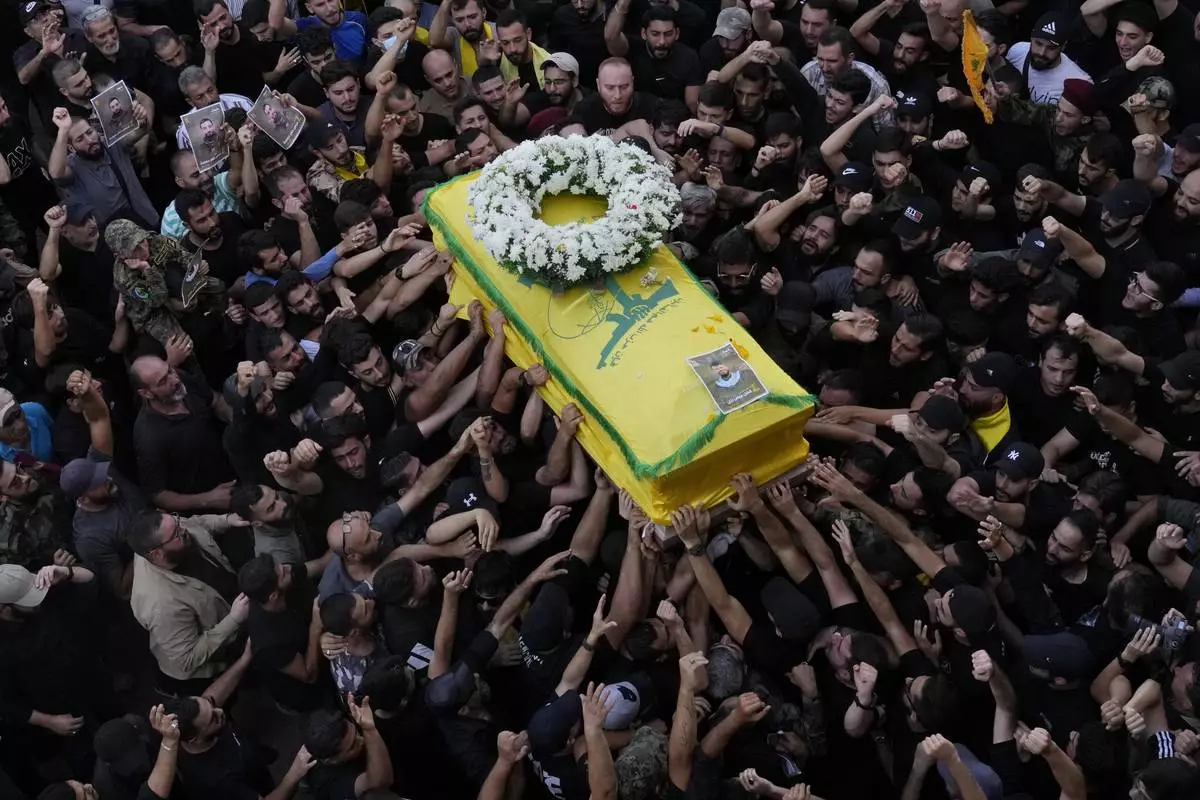
Hezbollah members carry the coffin of their comrade who was killed when a handheld device exploded, during a funeral procession in the southern suburbs of Beirut, Thursday, Sept. 19, 2024. (AP Photo/Hussein Malla)


































